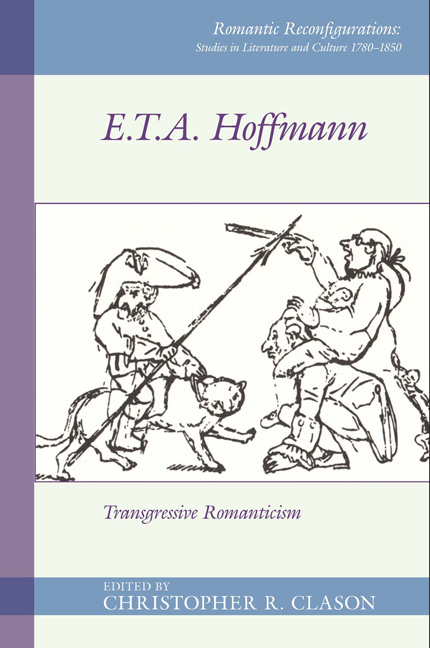Book contents
- Frontmatter
- Contents
- List of Figures
- Acknowledgements
- Notes on Contributors
- Introduction
- I Transgression and Institutions
- 1 “A Poor, Imprisoned Animal.” Persons, Property, and the Unnatural Nature of the Law in E.T.A. Hoffmann's “Das Majorat”
- 2 Vergiftete Gaben: Violating the Laws of Hospitality in E.T.A. Hoffmann's “Das Fräulein von Scuderi”
- 3 Transgressive Science in E.T.A. Hoffmann's Fantastic Tales
- II Transgression and the Arts
- III Transgression in the Märchen
- IV Transgression of Reception in Kater Murr
- Works Cited
- Index
2 - Vergiftete Gaben: Violating the Laws of Hospitality in E.T.A. Hoffmann's “Das Fräulein von Scuderi”
from I - Transgression and Institutions
- Frontmatter
- Contents
- List of Figures
- Acknowledgements
- Notes on Contributors
- Introduction
- I Transgression and Institutions
- 1 “A Poor, Imprisoned Animal.” Persons, Property, and the Unnatural Nature of the Law in E.T.A. Hoffmann's “Das Majorat”
- 2 Vergiftete Gaben: Violating the Laws of Hospitality in E.T.A. Hoffmann's “Das Fräulein von Scuderi”
- 3 Transgressive Science in E.T.A. Hoffmann's Fantastic Tales
- II Transgression and the Arts
- III Transgression in the Märchen
- IV Transgression of Reception in Kater Murr
- Works Cited
- Index
Summary
In an extended prologue to his 1819 novella “Das Fräulein von Scuderi,” E.T.A. Hoffmann offers an account of a sudden outbreak of violence in Paris in the seventeenth century. A new form of poison is invented that is virtually untraceable. And although the initial perpetrator is quickly caught and executed, the technique for manufacturing the poison begins to spread, passing from one perpetrator to another, claiming ever more victims, and escaping juridical efforts to suppress it. What I find most striking about Hoffmann's novella is that he represents the migration of violence across Paris as disrupting traditional forms of reciprocity: the giving of gifts, the granting of charity, and the expression of hospitality. What makes the violence so disruptive, so calamitous for society, Hoffmann seems to say, is that it contaminates, indeed literally poisons, rituals of gift exchange. The gift, and the granting of gifts, becomes the site of violence. These themes – first developed in the prologue to the novella, in which Hoffmann describes the invention of the poison – persist in the main body of the narrative, in which he offers an account of a seemingly unrelated series of murders and jewelry thefts that take place in the streets of Paris after dark.
My reading of Hoffmann, in focusing on rituals of reciprocity, goes against the grain of much recent criticism on the novella, which has tended to emphasize either questions of genre (whether or not the text is an early example of detective fiction), of genius (to what extent the gifted but murderous jeweler René Cardillac represents a parody of the Romantic cult of the artist), or of criminal psychology (to what extent the novella locates the origins of criminality in early childhood). I proceed here instead by examining a set of tropes and idioms that Hoffmann makes use of to describe the spread of violence, and I argue that Hoffmann's novella constitutes an attempt, in the face of this violence, to develop a set of resources – be they political, judicial, or even literary – that, in the absence of traditional forms of gift giving, might contain violence, once it has begun to spread.
- Type
- Chapter
- Information
- E. T. A. HoffmannTransgressive Romanticism, pp. 45 - 64Publisher: Liverpool University PressPrint publication year: 2018



